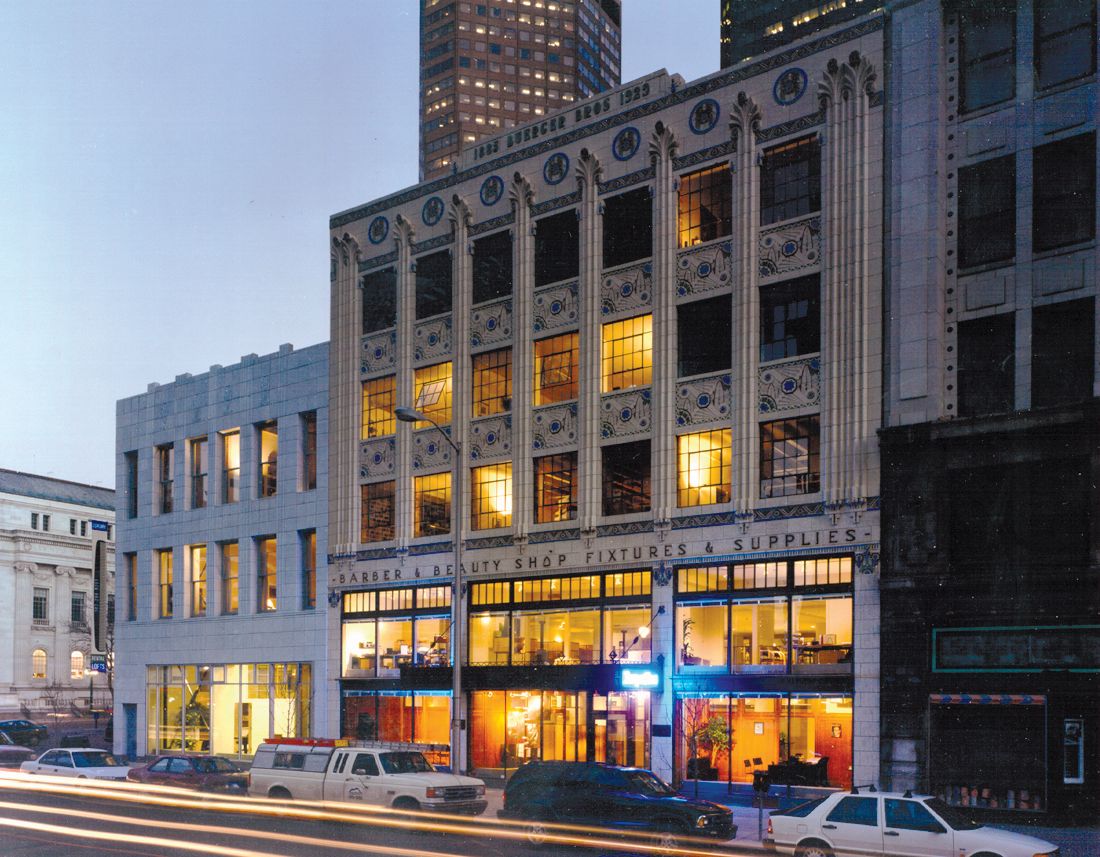Booming cities benefit by respecting existing architecture
Places like Denver struggle with the best use for historic buildings
Jim Bershof //October 12, 2016//


Booming cities benefit by respecting existing architecture
Places like Denver struggle with the best use for historic buildings
Jim Bershof //October 12, 2016//

From LoDo to RiNo, Fort Collins to Colorado Springs, it seems like the pace of Colorado construction can’t keep up with demand. As out-of-staters and new businesses catch on to the desirability of our state, the need for more office and residential space is urgent. As a result, builders, architects and city leaders are grappling with difficult questions regarding the best use of existing buildings – should they stay or should they go?
As an architect it’s impossible not to be excited by the creative new designs popping up around Colorado, incorporating modern aesthetics and cutting-edge new technology. Innovative upcoming projects like Denver’s first cross-laminated timber office at 15th and Platte or the new World Trade Center building in River North (RiNo) are cementing Denver’s place on the map as one of the country’s most desirable cities to live, work and play.
Interestingly, during the 1960’s and 1970’s, when urban renewal swept through the country, Denver actually lost dozens of original buildings in an effort to ‘modernize’ the city’s infrastructure. We weren’t alone in this – cities across the U.S. tore down their older buildings to make way for projects that some of us now might tactfully call ‘dated.’
Still, Denver was fortunate that even amid the mid-century craze to modernize, a few residents and developers – starting with Dana Crawford and Mickey Zeppelin – saw the error of demolishing the past. A small but vocal group, including Historic Denver and the Denver Landmark Preservation Commission, formed and continue to help preserve and protect many of most treasured and valuable places in our city including Larimer Square, The Hotel Teatro and Union Station.
It’s become obvious that the “latest and greatest” designs of the 1960’s -1980’s lack the appeal needed to meet the demands and taste levels of today’s discerning buyers and business owners, which also means these buildings can have a more difficult time commanding the high-rent that their more attractive counterparts – historic buildings – can deliver.
Denver still has hundreds of century-old brick buildings, former factories and warehouses, many of which have been abandoned or fallen into disrepair, and, according to some, are hindering a much-needed path to growth. In an effort to create higher-density properties downtown, people may call for razing these needy buildings and constructing new, modern and more energy-efficient structures. After all, isn’t it more time consuming, expensive and labor-intensive to restore an old building than to erect a new one? And don’t new buildings bring in higher rent, faster growth and more visibility for a city?
Not necessarily. Preservation and adaptive reuse are actually extremely economically and environmentally valuable options that can generate economic benefit to our cities.
Sustainability is an oft-cited reason for demolishing older buildings and constructing new ones, yet a study by the Preservation Green Lab concluded that it can take between 10 and 80 years for a new, energy-efficient building to overcome, through more efficient operations, the negative energy and climate change impacts caused in its construction process.
In pure real estate value, character-rich cities tend to be more attractive to potential residents and businesses. Christopher Leinberger from the Urban Land Institute argues that the high degree of “authenticity” inherent in historic cities makes them highly attractive places to live and work, particularly to those in creative and entrepreneurial industries.
 A study conducted by the National Trust for Historic Preservation confirms this, demonstrating a clear connection between a greater concentration of creative jobs and diverse neighborhoods full of older buildings. Case in point: when Google moved its Manhattan offices, did they choose a new skyscraper in Midtown? No, rather the company renovated and moved into a 1930’s building in the city’s historic meatpacking district.
A study conducted by the National Trust for Historic Preservation confirms this, demonstrating a clear connection between a greater concentration of creative jobs and diverse neighborhoods full of older buildings. Case in point: when Google moved its Manhattan offices, did they choose a new skyscraper in Midtown? No, rather the company renovated and moved into a 1930’s building in the city’s historic meatpacking district.
Cities and neighborhoods with historic properties and districts are generally viewed as more desirable. In fact, studies have shown a 20 percent premium is placed on properties located in areas that are or will become historic districts. In addition, properties just outside the boundaries of historic neighborhoods also experience increases in price. So although we can’t, and wouldn’t want to, prevent new construction in downtown Denver, the existence of our historic buildings and neighborhoods is actually a key contributor to the marketability and attractiveness of the new developments, allowing them to capitalize on the benefits of the neighborhood they’re located in.
Neighborhoods brimming with unoccupied or under-utilized buildings are also ripe for the economic revitalization that adaptive reuse can bring. For example, in Denver’s now thriving RiNo neighborhood, the rehabilitation of properties like the neglected former school supply warehouse that was transformed into INDUSTRY, now a top-tier creative and technology industry anchor, is a case in point.
The restoration of INDUSTRY, The Bindery on Blake, OZ Architecture’s office at 3003 Larimer and numerous other adaptive reuse projects, will contribute enormously to protecting the character of this unique urban area, while also helping reinvigorate economically an evolving industrial part of Denver.
Finally, “heritage tourism” offers another financial reason for the preservation of historic buildings in Denver. Heritage tourists, or visitors whose primary reason for traveling is to visit historic places, typically spend more money and stay longer than other types of tourists. “Flagship” historic cities and districts in places like Boston, New Orleans and San Diego’s Gaslamp Quarter all attract a steady stream of heritage tourists because of their rich history, character and charm and Colorado benefits from this concept as well. We already know Larimer Square and Union Station are national tourist destinations, and their historical significance can’t be underscored enough in those cases.
The economic arguments for adaptive reuse are clear, but there is also something to be said for the intangible and unquantifiable appeal of historic neighborhoods. Perhaps this is because even the best built and most lovingly designed new neighborhoods just can’t compete with the character of cities rich in the unique architecture of a different time and place.
Popular gastro-pub and entertainment venue Punch Bowl Social validates this theory with the purposeful placement of seven of its locations in buildings that previously served other purposes—their current renovation of Denver’s old Stapleton Airport tower being a notable example—thereby confirming the idea that there’s just something about old buildings that creates a more authentic and desirable experience for customers.
Okay, Historic Renovation is a Good Idea – Now How Do I Do It?
Historic renovations, for all their charm in the end, can be a complicated process to begin, which means that engaging the right resource – one that is well-versed in adaptive reuse – is the most important first step.
Architects seasoned in historic renovations can offer invaluable guidance in determining whether or not a property is able to be rehabbed and counsel on the best ways to work within the pre-established confines of the original structure while still accommodating its new function.
Experienced architects that have frequently worked with city design committees and review boards are critical since zoning codes and approval processes can be complex. They can also counsel on potential government tax credits and incentives that may be offered to developers who choose to rehab and preserve historic structures. Ideally, the challenges inherent in historic renovation should help drive collaboration, new thinking, and spur creative problem solving.
Repurposing historic buildings for new uses is not only one of the biggest trends in development today; it’s also economically viable, environmentally friendly, and a significant way to cement the appeal of a city with residents, tourists and potential businesses. Even architects and builders who love the vision and energy of new design can’t ignore the simple truth about Denver, which is that our historic buildings add both tangible and intangible benefits to our city and create an authentic, differentiated, and inspired environment.
Rebecca Stone, AIA, LEED AP BD+C, is a principal with OZ Architecture. Her work for hospitality and resort clients and multi-family/mixed use projects reflects her guiding principle — designing dynamic environments that enrich their communities and set the highest of standards.
Jim Bershof, FAIA, LEED AP, a principal with OZ Architecture, has spent his 30-plus-year career in Colorado designing multi-family, civic, institutional, and commercial projects. He has a special interest in revitalizing historic buildings and celebrated landmarks, as well as urban infill projects of all types.



























